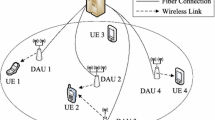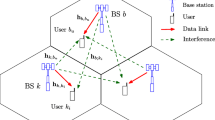Abstract
A power splitting approach for simultaneous wireless information and energy transfer is provided in this paper. We consider coordinated multipiont downlink transmission with M base stations (BSs) and J mobile stations (MSs). The main goal of this paper is to maximize per-MS data rate and receiving energy by dynamically optimizing transmitting beamformer. To improve fairness, this problem can be formulated to maximize the minimum rate of all J MSs with per-BS transmitting power constraints and per-MS receiving energy constraints, which is NP-hard problem. Minimum mean square error receiver, affine approximation and alternative convex optimization (ACO) methods are introduced to decompose the original NP-hard problem to several convex subproblems which can be solved by second-order cone programming with low rank (which is equal to the number of data streams) solutions, and then a fast heuristic algorithm is provided to solve the original problem. Numerical results show that the proposed algorithm can achieve fairness, and outperforms sum rate scheme in terms of fairness and outage probability. The fast convergency also demonstrates the proposed algorithm’s good performance.











Similar content being viewed by others
References
Jungnickel, V., Manolakis, K., et al. (2014). The role of small cells, coordinated multipoint, and massive MIMO in 5G. IEEE Communications Magazine, 52, 44–51.
Osseiran, A., et al. (2014). Scenarios for the 5G mobile and wireless communications: The vision of the METIS project. IEEE Communications Magazine, 52, 44–51.
Dolgov, A., Zane, R., & Popovic, Z. (2010). Power management system for online low power RF energy harvesting optimization. IEEE Transactions Circuits and Systems, 57, 1802–1811.
Zhang, R., & Ho, C. K. (2013). MIMO broadcasting for simultaneous wireless information and power transfer. IEEE Transactions on Wireless Communications, 12, 1989–2001.
Krikidis, I., Timotheou, S., Nikolaouand, S., Zheng, G., Ng, D. W. K. Z., & Schober, R. (2014). Simultaneous wireless information and power transfer in modern communication systems. IEEE Communications Magazine, 52, 104–110.
Nintanavongsa, P., Muncuk, U., Lewis, D. R., & Chowdhury, K. R. (2012). Design optimization and implementation for RF energy harvesting circuits. IEEE RFID Virtual Journal, 2, 24–33.
Pinuela, M., Mitcheson, P. D., & Lucyszyn, S. (2013). Ambient RF energy harvesting in urban and semi-urban environments. IEEE Transactions on Microwave Theory and Techniques, 61, 2715–2726.
Varshney, L. R. (2008). Transporting information and energy simultaneously, IEEE Int. Symp. Inf. Theory (ISIT), pp. 1612–1616
Grover, P., & Sahai, A. (2010) Shannon meets Tesla: Wireless information and power transfer, IEEE Int. Symp. Inf. Theory (ISIT), pp. 2363-2367
Liu, L., Zhang, R., & Chua, K. (2013). Wireless information transfer with opportunistic energy harvesting. IEEE Transactions on Wireless Communications, 12, 288–300.
Zheng, G., Ho, Z., Jorswieck, E. A., & Ottersten, B. (2014). Information and energy cooperation in cognitive radio networks. IEEE Transactions on Signal Processing, 62, 2290–2303.
Krikidis, I., Timotheou, S., & Sasaki, S. (2012). RF energy transfer for cooperative networks: Data relaying or energy harvesting? IEEE Communications Letters, 16(11), 1772–1775.
Shen, C., Li, W.-C., & Chang, T.-H. (2014). Wireless information and energy transfer in multi-antenna interference channel. IEEE Transactions on Signal Processing, 62, 6249–6264.
Timotheou, S., Krikidis, I., Zheng, G., & Ottersten, B. (2014). Beamforming for MISO interference channels with QoS and RF energy transfer. IEEE Transactions on Wireless Communications, 13, 2646–2658.
Shi, Q., Xu, W., Chang, T.-H., Wang, Y., & Song, E. (2014). Joint beamforming and power splitting for MISO interference channel with SWIPT: An SOCP relaxation and decentralized algorithm. IEEE Transactions on Signal Processing, 62, 6149–6208.
Park, J., & Clerckx, B. (2014). Joint wireless information and energy transfer in a K-user MIMO interference channel. IEEE Transactions on Wireless Communications, 13, 5781–5796.
Rubio, J., & Pascual-Iserte, A. (2013). Simultaneous wireless information and power transfer in multiuser MIMO systems, IEEE Global Communications Conference (GLOBECOM), pp. 2755-2760
Wu, J., Zhang, Z., Yu, H., & Wen, Y. (2015). Cloud radio access network (C-RAN): A primer. IEEE Network, 29, 35–41.
Liu, C., Zhang, L., Zhu, M., Wang, J., Cheng, L., & Chang, G.-K. (2013). A novel multi-service small-cell cloud radio access network for mobile backhaul and computing based on radio-over-fiber technologies. IEEE Journal of Lightwave Technology, 31, 2869–2875.
Zhang, J., Chen, R., Andrews, J. G., Ghosh, A., & Heath, R. W, Jr. (2009). Networked MIMO with clustered linear precoding. IEEE Wireless Communications, 8, 1910–1921.
Shigeta, R., Sasaki, T., Quan, D. M., Kawahara, Y., Vyas, R. J., Tentzeris, M. M., et al. (2013). Ambient-RF-energy-harvesting sensor device with capacitor-leakage-aware duty cycle control. IEEE Sensors Journal, 13, 2973–2983.
Gerlach, D., & Paulraj, A. (1996). Base station transmitting antenna arrays for multipath environments. Signal Processing, 54, 59–73.
Boche, H., & Schubert, M. (2006) Resource allocation in multiantenna systems-achieving max-min fairness by optimizing a sum of inverse SIR, IEEE Trans. on Signal Processing, 54, pp. 1990 C 1997
Liu, Y.-F., Dai, Y.-H., & Luo, Z.-Q. (2013). Max–min fairness linear transceiver design for a multi-user MIMO interference channel. IEEE Transactions on Signal Processing, 61, 2413–2423.
Cai, D., Quek, T., & Tan, C. W. (2011). A unified analysis of max–min weighted sinr for mimo downlink system. IEEE Transactions on Signal Processing, 59, 3850–3862.
Razaviyayn, M., Hong, M., & Luo, Z-Q, (2012) Linear Transceiver Design for a MIMO Interfering Broadcast Channel Achieving Max-Min Fairness
Luo, Z.-Q., Ma, W.-K., So, A. M.-C., Ye, Y., & Zhang, S. (2010). Semidefinite relaxation of quadratic optimization problems. IEEE Signal Processing Magazine, 27, 20–34.
Vandenberghe, L., & Boyd, S. (1996). Semidefinite programming. SIAM Review, 38, 49–95.
Lobo, M., Vandenberghe, L., Boyd, S., & Lebret, H. (1998). Applications of second-order cone programming. Linear Algebra and its Applications, 284, 193–228.
Zhao, L., Liang, K., Cao, G., Qian, R., & Lopez-Perez, D. (2014). An enhanced signal-timing-offset compensation algorithm for coordinated multipoint-to-multiuser systems. IEEE Communications Letters, 18, 983–986.
Christensen, S. S., Agarwal, R., de Carvalho, E., & Cioffi, J. M. (2008). Weighted sum-rate maximization using weighted MMSE for MIMO-BC beamforming design. IEEE Transactions on Wireless Communications, 12, 4792–4799.
Boyd, S. EE364b: Convex Optimization II, available at http://stanford.edu/class/ee364b/
Grant, M., & Boyd. S. (2013) CVX: Matlab software for disciplined convex programming, version 2.0 beta. http://cvxr.com/cvx, September
Acknowledgments
This work was supported in part by the program of China Scholarships Council (No. 201406960046), National Natural Science Foundation of China (No. 61372070), Natural Science Basic Research Plan in Shaanxi Province of China (2015JM6324), Hong Kong, Macao and Taiwan Science & Technology Cooperation Program of China (2015DFT10160), EU FP7 Project MONICA (PIRSES-GA-2011-295222), National High-Tech R & D Program (863 Program 2015AA015701), UK EPSRC Project DANCER (EP/K002643/1), the National High-Tech R&D Program (863 Program 2015AA015701) and the 111 Project (B08038).
Author information
Authors and Affiliations
Corresponding authors
Appendices
Appendix 1: Proof of Theorem 1
Since (26a) and (26c) are affine objective and constraint, respectively, we only have to represent the rest constraints (26b) and (26d). By introducing slack variables \(q_{j,m}, \forall j \in \mathcal {J}, m\in \mathcal {M}\), (26d) is equivalent to
where (33) can be further rewritten as [29]
Then, the transformation of (26d) is finished.
Next, the constraint (26b) is equivalent to
then we represent \(\bar{E}_j\) as follows:
Similar to the case in (26d), by introducing slack variables \(\zeta _{j,i}, \forall j,i \in \mathcal {J} \), equation (36) is equivalent the following equations:
where (38) and (39) can be further rewritten as
Appendix 2: Proof of Corollary 1
Letting \(\mu _j = \gamma _j^2, \forall j \in \mathcal {J}\) and then \(\bar{E}_j\) can be rewritten as follows
After substituting it to the first constraint of (30), we have
and finally we can get
It is easy to transform the second constraint of (30) by \(\gamma ^2 <= N_j\) and then reformulate it as follows:
Rights and permissions
About this article
Cite this article
Liang, K., Zhao, L., Yang, K. et al. A Fair Power Splitting Algorithm for Simultaneous Wireless Information and Energy Transfer in CoMP Downlink Transmission . Wireless Pers Commun 85, 2687–2710 (2015). https://doi.org/10.1007/s11277-015-2928-7
Published:
Issue Date:
DOI: https://doi.org/10.1007/s11277-015-2928-7




